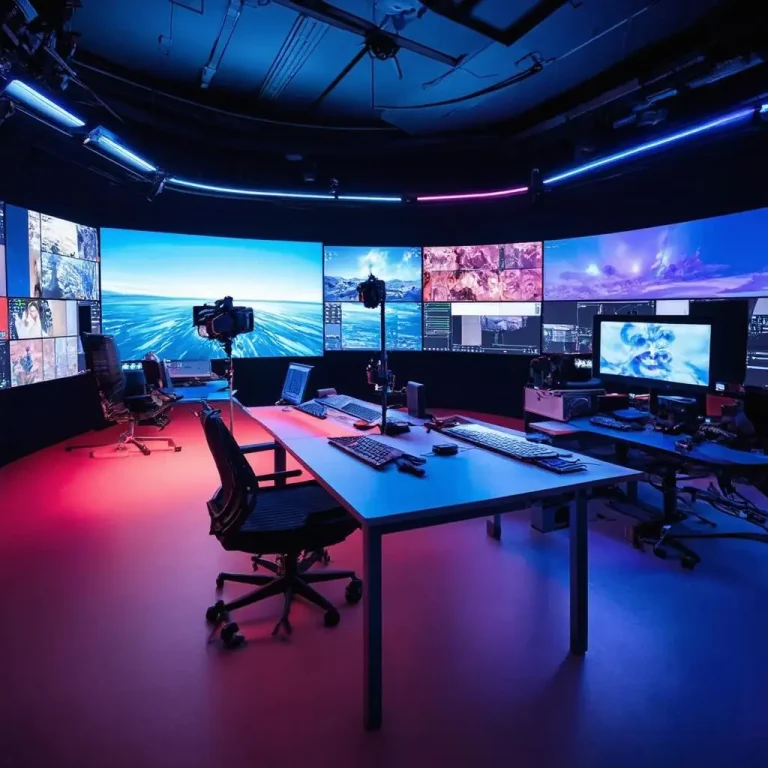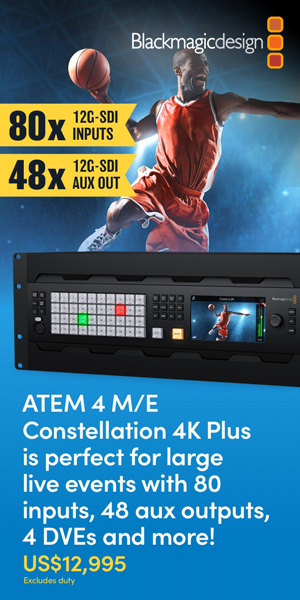High-Resolution (or “Hi-Res”) will probably be on the lips of everyone who has anything to do with the studio industry in perpetuity. No matter what the resolution is at any given time, there will always be a higher resolution being strived for. While 4K has already become a reality for professional who record in it and perform post-production with it as well, it is because a 4K Ultra HD TV (or UHDTV) at eight million pixels delivers four times the picture resolution of 1080p Full HD, which is a mere two million pixels; in other words, many more pixels to play with.
Most in the industry believe that if their content is recorded in the highest resolution available, it will “future-proof” their content, ensuring its value for years to come. However, the industry changes so fast that even that hope is already outdated.
For example, following that logic, someone not too long ago would have reasoned that placing their super 8 home movies on a VHS tape would future-proof that content. Logic: FAIL.
But the industry is not standing around waiting for the hi-res format to suddenly be available to consumers without fully understanding and preparing for it themselves long beforehand. There are many key players in the broadcast/post-production side of the industry, but one of the foremost is Avid.
I don’t have to go into who “Avid” is, because if you’re in the industry, you already know who they are. If you’re not in the industry, go to www.avid.com and you’ll see. But to move this article along, I’ll assume you already know Avid.
The 2014 Nab Show saw Avid introduce their newest service – “Avid Everywhere.” I covered the announcement quite extensively while at the Show, and wrote about it – here is a link to that article: Avid Everywhere
According to Avid, the first real advance in the UHDTV technology is going to occur soon (this year or next, 2015). They have predicted frame rates capped at 60fps (progressive only), up to “4K” resolution (3840×2160), 10/12 bit color – (no more 8 bit), Bt.2020 or 709 color space, HEVC compression, and audio 5.1 and 7.1; Between 2015 and 2020, it is believed that frame rates will be increased to 120Hz, with advances in video and audio; finally, in 2020, for the Tokyo Olympics, a prediction of 7280×4320 “8K” resolution (Japan’s Super High Vision – In August, 2012, the International Telecommunication Union (ITU) approved a set of high-resolution standards developed by NHK Labs as their ITU-R Recommendation BT.2020 UHDTV specification for Ultra High-Definition Television). This 8K will deliver 16 times the HD resolution, coming in at a mind-blowing 33 million pixels.
And while the different “K’s” have been lagging, with the higher resolutions available only to those production and post-production houses (and NOT to the Joe Blow Consumer who is itching for such high quality), at least in some parts of the world the idea of getting 4K out to the consumer is not only alive, but kicking up a storm!
According to their Press Release, Homechoice was responsible for an industry first on April 10, 2014. On that date, Homechoice launched UMAX, the first UHD cable channel in the world, broadcast in 4Kp60 (3840×2160 pixel resolution with 60 frames per second).
TITAN is chosen for exceptional video quality and compatibility – TITAN is ATEME¹s next generation TV Head-End, a real-time multi-channel/format encoder/transcoder for multi-screen delivery of linear channels and video-on-demand. Homechoice selected TITAN for its best-in-class picture quality (using 32mbps for 4Kp60) and for its proven compatibility with embedded decoders in today¹s most popular TV brands.
No set-top box required – by leveraging the HEVC decoding capabilities built into UHDTV compatible televisions – and downloading an application to decrypt UMAX on their TV – cable television subscribers across South Korea will have access to the most recent UHD content
Original content – the initial launch of UMAX will include 40 original programs, a mix of films, documentaries and animation, which will run from 6 a.m. to 2 a.m. KST. Homechoice plans to increase its offering to 100 programs by the end of 2014.
No cost to subscribers – UMAX is funded and distributed by all South-Korean MSOs (CJ Hellovision, C&M, T-Broad and HCN) and is available at no additional charge to subscribers in 2014.
“With the integration of HEVC capabilities into UHDTV television sets, and a cable channel that will provide consumers with the capability to enjoy this advanced technology today, cable programmers around the world will be watching the launch of UMAX with great interest. We are proud to be a part of the worldwide launch of the first 4K cable channel,” says Eunsook Wi, APAC regional manager, ATEME.
Obviously, this has just happened, so the affects cannot yet be measured. Broadcast Beat will keep you posted as information and data becomes available.
It is interesting to note that the 4K digital cinema standard is native 4096×2160 resolution and the UMAX format is 3840×2160, which is double both the horizontal and vertical measurements of the 1920 x 1080 consumer standard or 1080p “Full HD.” So, it isn’t “true” 4K; but it’s close enough that it won’t matter.
Meanwhile, back at the ranch, at the 2014 NAB Show, it was ALL about the pixels. While the different “K’s” were mentioned (2K, 4K, 8K, etc.), the real emphasis was on pixels – and the quality of the pixel itself, rather than how many you could fit on the screen. In addition to how great hi-res is for post and “future-proofing” content, it’s not much good unless you can see the difference.
Most people can’t really tell the difference between 2K and 4K – these are the limitations of the human eye. But I spoke to somebody at the Show – who requested to remain nameless (for fear of industry reprisal) – who commented that a 2K screen with “enhanced” pixels sitting next to a 4K screen gave a much crisper and sharper image – AND IT WAS TRUE! Well, the illusion was true, anyways. It was like sleight of hand… pick a pixel, any pixel…
Apparently, there is a relatively new “trick” (for want of a better term) applied to LCD’s that enables an apparent resolution improvement by controlling individual subpixels rather than the pixels, in a process called “Subpixel-based Downsampling” – in other words, enhanced sharpness via increased luminescence (See the Whitepaper HERE).
Subpixels, you say? Never heard of them! In black and white, you only need the pixel, which shows black and white. However, for color, you need subpixels of red, green and blue. Ah, RGB… sound familiar? Yes, it’s all down to that.
Before I launch into my “pixel tirade,” let me say a few things about the three main types of monitors – plasma, LCD and OLED. Plasma is almost history – despite its ability to produce the richest and darkest blacks, to get whites and the brightness necessary to make plasma worthwhile, it takes too much power. OLED’s use the least amount of power and are the brightest without having to be backlit, but the circuits wear out – the blue element of the RGB trio, first. Also, OLED screens are expensive, because there’s a low manufacturing rate of success. But that’s a different article. LCD is still the best, of the three, even though it requires a back light and, until recently, could not be bent or created in any configuration other than flat (curved LCD screens now available in the UK).
Back to the pixel. In black & white (or “monochrome”) systems, the pixel is the smallest unit that can be addressed. On color displays, each pixel contains red, green and blue “subpixels,” making it the smallest unit that can be addressed. It is the software that addresses the pixel and subpixels that make up the pixel. It is interesting to note that, in storage, pixels are made up of one or more bits, with “bit depth” representing the number of shades (mono or color). Of course, the most economical for storage purposes is monochrome, which uses just one bit per pixel (on/off). Gray scale and color typically use from 4 to 24 bits per pixel, providing from 16 to 16 million colors (256 shades of red x 256 shades of green x 256 shades of blue).
Through the careful control and variation of the voltage applied, the intensity of each subpixel can range over 256 shades. When combined, the subpixels produce a possible palette of 16.8 million colors, which take an extremely high number of transistors. To put it into perspective, a typical laptop computer supports resolutions up to 1,024×768. If the 1,024 columns were multiplied by the 768 rows, then multiplied by each of the 3 subpixels, we get 2,359,296 transistors etched onto the glass! When there is a problem with any of these transistors, a “bad pixel” is created on the display. Considering that fact, it’s not too unbelievable that many active matrix displays have several bad pixels in various places across the screen.
So, when you get right down to it, it’s the pixel that controls hi-res. Whether it’s in the quantity or the quality (or process), it all comes down to the picture cell. From “how many your camera sensors can record” to “how many your monitors can display,” and via whichever process, the world of high-resolution revolves around the pixel.
- JVC Flexes Its Muscles For Strongman Competition Livestreams - November 22, 2021
- CONNECT ramps up its NMS SaaS offer with a new cloud-powered solution - November 18, 2021
- Chulalongkorn University Uses Blackmagic Design Workflow for Online and Streaming Classes - August 25, 2020















